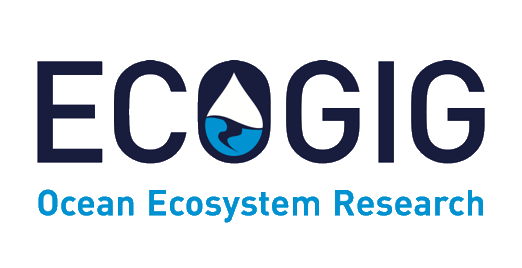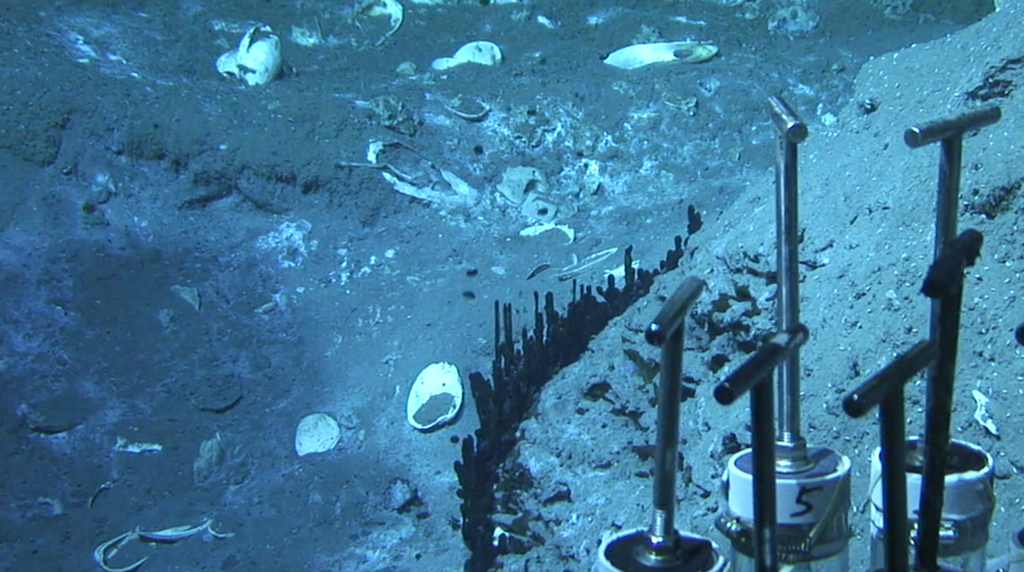History of Gulf ECOGIG Research Program
The April 20, 2010 Macondo well blowout in the Gulf of Mexico resulted in the explosion and sinking of the Deepwater Horizon drilling platform and the death of 11 rig workers. Nearly 5 million barrels (206 million gallons) of oil and between 1.55 and 3 million barrels (65–126 million gallons) of equivalent natural gas were discharged into the Gulf of Mexico at a depth of 5,000 feet. ECOGIG (Ecosystem Impacts of Oil and Gas Inputs to the Gulf) is one of several research consortia awarded grants by the Gulf of Mexico Research Initiative (GoMRI), a 20-member independent research board created to allocate the funds committed by BP for independent research programs following the accident.
The Gulf ECOGIG Research Program brings together physical oceanographers, marine biologists, and biogeochemists from multiple research institutions in a holistic effort to understand the fate and impacts oil and gas on deepwater ecosystems in the Gulf, and to chart the long-term effects and mechanisms of ecosystem recovery.
The Gulf ECOGIG Research Program was funded by GOMRI from 2011 until 2019. After the GOMRI-funded project, ECOGIG will become a network of research projects aiming to understand the environmental impacts of natural and anthropogenic impacts of hydrocarbons in deep sea ecosystems.
Mission of Gulf ECOGIG Research Program
Our mission is to understand the environmental impacts of natural and anthropogenic (human-caused) hydrocarbon inputs on deepwater ecosystems in the Gulf of Mexico. Specifically, our goals are to: 1) quantify the impacts, fates and dynamics of natural and anthropogenic oil and gas inputs, and 2) evaluate specific biological responses and adaptations to hydrocarbon exposure and to perturbations, both natural and anthropogenic.
Gulf ECOGIG Research Program (ECOGIG-2) Partner Institutions:
University of Georgia (lead institution and administrative unit)
Bigelow Laboratory for Ocean Sciences
Florida State University
Georgia Institute of Technology
Harvard University
Lamont-Doherty Earth Observatory at Columbia University Earth Institute
Oregon State University
Pennsylvania State University
Skidaway Institute of Oceanography
Temple University
University of California Santa Barbara
University of Maryland Center for Environmental Science & Chesapeake Biological Laboratory
University of New Hampshire
University of North Carolina Chapel Hill
University of Southern Mississippi
University of Texas Austin
Gulf of Mexico Overview
The Gulf of Mexico ecosystem is a hotspot for biological diversity and supports a number of industries, from tourism to fishery production to oil and gas exploration, that serve as the economic backbone of Gulf coast states. The Gulf is a natural hydrocarbon basin, rich with stores of oil and gas that lie in reservoirs deep beneath the seafloor. The natural seepage of hydrocarbons across the Gulf system is extensive and, thus, the system’s biological components experience ephemeral, if not, frequent, hydrocarbon exposure. In contrast to natural seepage, which is diffuse and variable over space and time, the 2010 Macondo oil well blowout, represented an intense, focused hydrocarbon infusion to the Gulf’s deepwaters. The Macondo blowout drove rapid shifts in microbial populations and activity, revealed unexpected phenomena, such as deepwater hydrocarbon plumes and marine “oil snow” sedimentation, and impacted the Gulf’s pelagic and benthic ecosystems. Understanding the distribution and fate of Macondo oil was limited to some degree by an insufficient ability to predict the physical movement of water in the Gulf. In other words, the available physical oceanographic models lacked critical components. In the past six years, much has been learned about the physical oceanography of the Gulf, providing transformative knowledge that will improve the ability to predict the movement of water and the hydrocarbons they carry in future blowout scenarios. Much has been learned about the processing and fate of Macondo hydrocarbons.
Gulf of Mexico Ecosystem
The Gulf of Mexico (Gulf) is prolific hydrocarbon basin. Approximately 22,000 natural seeps have been identified from seismic data (http://1.usa.gov/1aKybyq), and 1000 of these generate perennial oil slicks that are visible from space. Active seep zones in the Gulf, characterized as seepage cells, are found across the entire ecosystem, though seeps are more abundant in the northwest and central sectors. Hydrocarbon fluxes and distributions in the Gulf are strongly modulated by geophysical forcing, including salt tectonics and complex ocean circulation. The Gulf’s naturally occurring benthic and pelagic communities experience fluctuating physical regimes and geochemistry, which together act to induce dramatic variations in hydrocarbon exposure. Natural seepage provides an analog to accidental hydrocarbon releases, albeit at a much lower discharge rate. The responses of biological communities to changing hydrocarbon exposure and the role these factors play in defining the ability of these communities to endure hydrocarbon exposure remain poorly understood, even at high flux cold seeps. The seepage of oil and gas at cold seeps inherently connects the Gulf’s surface waters to the seafloor. Cold seeps in the Gulf are sources of focused and intense inputs of light hydrocarbon gases and oil to seabed sediments and benthic communities, and, through mixing, to the overlying water column. For example, multiple lines of evidence show that there is an increase in phytoplankton biomass in surface waters affected by natural seeps.
In seep sediments, microbial communities oxidize a fraction of the oil and gas fluxing through the system, but hydrocarbon are still released into the water column where they may be further oxidized and/or assimilated by water column microbial populations. The energy-rich substrates present in seeping fluids, e.g. oil, gas and dissolved organic carbon, and by-products of seafloor hydrocarbon oxidation, e.g. hydrogen sulfide, fuel the establishment and growth of endemic seep chemosynthetic megafauna and opportunistic fauna that use seeps as foraging grounds. Once transformed through biological or chemical processes, seep hydrocarbons can be viewed as “petrocarbon”, which can be traced quantitatively through both biotic and abiotic compartments of the Gulf system.
Seeps also host enormous shallow gas hydrate deposits, whose presence influences oil and gas fluxes to the water column. At the seafloor, seeps increase habitat heterogeneity and support a variety of biological communities, ranging from well-adapted but poorly identified microorganisms, to thriving megafaunal assemblages based around biomass-dominant symbiotic tubeworms and mussels. Megafaunal biomass depends upon the metabolic byproducts of microbially processed deeply-sourced hydrocarbons. One consequence of seep microbial metabolism is authigenic carbonate formation, which traps mineralized carbon along the seabed. These carbonates can support colonial deep-water corals and a diverse associated community once seepage has declined, and provide a physically stable microbial habitat in a highly dynamic environment.
Gulf ECOGIG Research Program 1 (ECOGIG-1; 2012-2014) Accomplishments:
In contrast to natural seeps, the Deepwater Horizon (DWH) blowout generated a suite of unexpected phenomena, many of which were discovered by ECOGIG researchers. We were the first to document the DWH-driven “deepwater plume” and to examine its effects on Gulf pelagic and benthic environments. Diverse deep-sea, cold adapted microorganisms responded within hours to hydrocarbon exposure, revealing a remarkable metabolic potential of rare members of the in situ community. Rare microbial species bloomed, the community shifted to one dominated by hydrocarbon oxidizers and hydrocarbon oxidation activity increased impacting the Gulf's particulate carbon cycle and planktonic food web. Evidence from laboratory experiments suggests that dispersants shaped, and perhaps limited and altered, the microbial response. We aim to continue this work into ECOGIG-2 to offer a definitive qualitative and quantitative description of microbial response.
ECOGIG researchers were also the first to document a unique layer that carpeted the seafloor near and some distance from the wellhead. The origin of this layer was likely due to rapidly sinking marine “oil snow” particles with size of 0.5 mm or larger, formed by the discharge of DWH oil. The Thorium-234 content of the layer indicates a large event was associated with the DWH discharge, which strongly suggests that the presence of extensive surface oil slicks led to extreme sedimentation. The lateral and vertical extension of the layer suggests that sedimentation accounted for a significant fraction of the hydrocarbons discharged into the environment, adding a new perspective to oil spill assessment and response planning. This phenomenon was unexpected, and thus was not included in the official Federal Government’s Oil Budget. The impact of deep hydrocarbon plumes and of extreme sedimentation events on deep-sea animals was severe and the ultimate fate of the impact communities is still unknown.
The ECOGIG program has pioneered cutting-edge technologies to investigate the Gulf system. We have developed surveillance techniques utilizing low-altitude overflights and digital photogrammetry for quantifying surface slicks with centimeter resolution. A time-lapse camera system to photograph aggregates was developed to document the temporal variability in particle settling velocities. This system also recorded a large resuspension event in September 2012, when benthic material was redistributed up to 400 m above the seafloor. An autonomous video time-lapse system perfected during ECOGIG was positioned at active oil and gas seeps; custom image processing generated precise time-series that allowed quantification of seepage rates. We utilized new landers to continuously measure methane, oxygen, currents and physical parameters at the seafloor for sustained periods. We pioneered oil degradation time-series experiments at the seafloor with the MIcrobial Methane Observatory for Seafloor Analysis (MIMOSA), by mimicking the depositional environment during the oil spill and tracking the fate of this carbon over time. MIMOSA has allowed ECOGIG to measure for the first time in-situ rates of carbon degradation in the presence of oil. We have worked with Webb Teledyne to achieve real-time programming, rapid profiling, and recovery of Lagrangian APEX profilers; we are currently developing data processing procedures for the DEEP-LISST to identify marine snow, oil and gas bubbles. Finally, we have developed novel two-way nesting algorithms coupled to tracer deployments in regional ocean model simulations of the Gulf to numerically investigate processes responsible for water column transport at the DWH and natural seep sites.
Gulf ECOGIG Research Program 2 (ECOGIG-2; 2015-2018) Accomplishments:
ECOGIG-2 builds upon the work done by ECOGIG-1 and researchers have produced over 120 publications that advance the understanding of the program's core research themes. The publications and team members for each theme can by found by clicking the links, which will take you to a separate page dedicated to each research theme.
Energetics & Ecosystem Modeling
Hydrocarbon & Dispersant Chemistry
Megafaunal (Coral) Ecology, Genetics & Proteomics
Plankton & Water Column Dynamics
Sedimentation & Resuspension Dynamics
Summary of Research Advances
The impacts of the Deepwater Horizon oil spill reached from the surface ocean to the seafloor in the Gulf of Mexico. This environmental disaster was, in effect, a large-scale accidental experiment from which the scientific community learned a great deal. The surprising distribution of oil and gas following the blowout, with 50% of the oil and 100% of the gas entrained in deep waters, made a comprehensive oil budget exceedingly difficult to assemble and underscored the need for quantifying the discharge rate throughout the incident so that the hydrocarbon influx can be tightly constrained. Similarly, a lack of widespread rate measurements of oil (and to some extent, gas) biodegradation rates left unbounded the degree to which biological oxidation served as a sink for discharged hydrocarbons. The discovery of sedimentation as a key fate for discharged oil can and should inform future response efforts, underscoring the need to quantify sedimentation rates across space and time; such data would help constrain the fate of oil and improve oil budgets.
Advances in Gulf physical oceanography over the past six years have been remarkable. We now have a much more detailed appreciation of fluid movements over a range of spatial and temporal scales and are in a stronger position to understand the movement of water – and associated hydrocarbons – should another offshore discharge occur. On-going efforts continue to advance and fine-tune circulations models to capture the dynamics of the Gulf system, with obvious and important implications for oil spill scenarios.
While it is clear that petrocarbon was incorporated into the Gulf’s food web, it is unclear how this incorporation occurred, whether by trophic transfer, accidental uptake, or sorption/uptake across cell or living surfaces (skin, membranes). While the impact of hydrocarbon exposure to the Gulf’s offshore biological communities was extensive, the damage could certainly have been much worse. Microbial communities responded rapidly to the hydrocarbon infusion, thanks largely to the existence of a low-abundance rare biosphere of microorganisms adept at hydrocarbon and dispersant biodegradation. Deepwater coral communities suffered widespread, negative impacts due to sedimenting marine oil snow. Dispersant exposure further damaged coral communities and may also impact their recovery. Fish populations in the Gulf, especially larvae of key game fish, exhibited a consistent pattern of cardiac impairment following oil/dispersant exposure. The long term impacts of oil exposure to fish populations are unknown but existing data suggest that a rigorous assessment of fishery-level impact(s) will require many more years of.
The Gulf of Mexico ecosystem contributes substantially to the Gulf coast and U.S. economy. Identifying and understanding the impacts of the Deepwater Horizon oil well blowout was impeded by the lack of baseline data for this critical ecosystem. In the future, it is absolutely essential to collect baseline data for systems that are at risk to be impacted by industrial activities. Without sufficient baseline data, it is nearly impossible to gauge and assign value to the ecosystem impacts resulting from large anthropogenic perturbations.


















 back to top
back to top